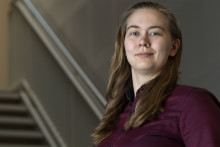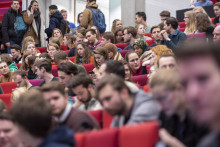There is much to be said about the relative positions of men and women in higher education, but one thing is clear: more women than men decide to pursue a Bachelor’s or Master’s degree, and they generally do better.
More women than men
At universities as well as at universities of applied sciences, more women than men enrol in a study programme. This is by no means a neck-and-neck race: in the 2021/22 academic year this difference amounted to many thousands of students.

© HOP. Source: UNL (university) and Statistics Netherlands (higher vocational education). Reference year: 2021/22.
Wo-bachelor = Bachelor’s programme, university. Wo-master = Master’s programme, university. Hbo-bachelor = Bachelor’s programme, higher vocational education
Things were different in the past
In the past women were less likely than men to enter a degree programme, but ever since 1997 more women than men were registered embarked on higher vocational education programmes, and nine years later the same happened at the universities.

© HOP. Source: Statistics Netherlands. The gap: in 1972 and 1973 students boycotted formal registration at universities. Hbo = higher vocational education. Wo = university. Black line = turning point.
Women are more likely to graduate
The gender gap gets even wider in education itself. Women complete their studies faster than men; at the universities, 77% of women obtain their Bachelor’s degree within three or four years, compared to only 61% of the men (Dutch universities have not made this information available for Master’s degrees).
At universities of applied sciences, 42% of male Bachelor’s students graduate within five years, compared to no less than 62% of female students. Within years these figures are 61% and 75% respectively.
So institutes of higher education award more diplomas to women than to men. Here, too, the differences number in the thousands.

© HOP. UNL (university) and Statistics Netherlands (higher vocational education). Reference year: 2021/22
Wo-bachelor = Bachelor’s degree, university. Wo-master = Master’s degree, university.
Hbo-bachelor = Bachelor’s degree, higher vocational education.
Young women are more often highly qualified
When more women than men pursue a degree and graduate, eventually women are more often highly qualified than men. In the 25-45 age group, women are clearly more likely to possess a degree from a university of applied sciences or university.

© HOP. Source: Statistics Netherlands. Age groups: 25 to 35 years etc.
PhDs
Although for many years now more women than men have obtained a diploma, they are relatively less likely to pursue an academic career. However, this could be changing. In the 2020/21 academic year, for the first time more women than men (six more) gained their PhD from a Dutch university.
In 2019, a research study by Universities of the Netherlands (UNL) also showed that men and women at Dutch universities were about equally likely to complete their PhD thesis; about three-quarters eventually succeed.

© HOP. Source: Statistics Netherlands and OCWincijfers
What about teaching staff?
Higher vocational education students are more likely to have female than male teachers: in 2021, 16,912 teachers at universities of applied sciences were male and 18,927 were female. At the universities this ratio depends on the type of teacher and researcher.
Of a total of almost 3195 university professors, only 858 are women (not counting endowed professors). This is about a quarter. There are no recent figures for lecturers in higher vocational education programmes, but in 2018 31% were women.

© HOP. Source: Association of Universities of Applied Sciences and WOPI data, UNL (reference year 2021)
From left to right: Hbo-docent = higher vocational education teacher. Professor = Full professor. Univ hoofddocent = associate professeor. Univ docent = assistant professor. Overig docent = other teacher. Overig onderzoeker = other researcher. Ondersteunend personeel = support staff
Wage disparities
Wage disparities between men and women are decreasing, but women still generally earn less than men. This is particularly evident in the business world, where men start earning substantially more than women from about the age of thirty. In government positions women start with an advantage, but this lead has disappeared by the time they are forty.

© HOP. Source: CBS







